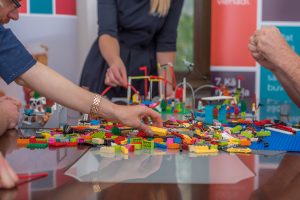
In today’s digital age, a well-thought out and developed project website serves as the gateway to showcasing project’s innovation, research results and achievements to various target audiences it will help to foster collaboration and drive impact.
To ensure your project stands out in the vast expanse of the internet, we’ve distilled the essential ingredients into “8 Best practices for Horizon Europe project websites”. From clarity in communication to seamless user experience, embark on a journey of digital excellence as we navigate the terrain of effective project representation online.
01. Simple navigation
Why simple navigation reigns supreme in website design.
Simple navigation on websites is essential for providing users with a smooth and intuitive browsing experience. As the project websites are mostly used for work, research, educational purposes, most of the project website statistics will demonstrate more desktop version users than mobile version users. Thus, so called burger navigation might not be the best solution.
Burger navigation, characterized by the iconic three-line menu icon resembling a hamburger, has become synonymous with mobile website design due to its space-saving nature. However, its implementation on desktop versions of websites can present challenges and drawbacks. Here are two main reasons why using burger navigation might not be the best choice.
1. Reduced discoverability: On desktop screens, burger navigation hides menu items behind an icon, making it less intuitive for users to discover and access navigation options. Unlike mobile devices where screen real estate is limited, desktop screens typically have more space available for displaying navigation menus directly.

2. Less efficient navigation: While burger navigation can help conserve space on mobile screens, it may not be necessary or practical on desktops where there is more room for displaying navigation options. Requiring users to click on the burger icon to reveal the menu adds an extra step to the navigation process, potentially slowing down users’ ability to find the information they need. It also requires user to constantly go to navigation when switching between pages.
While burger navigation may be suitable for mobile websites with limited screen space, its implementation on desktop versions can impede discoverability, accessibility, and efficiency. Instead, opting for visible and easily accessible navigation options on desktops can enhance user experience and ensure that visitors can navigate the website seamlessly.
02. EU emblem and funding acknowledgement
Wrong acknowledgement or not the best place.
Every Horizon Europe project website should have the EU emblem and acknowledgement. However, a lot of project websites that are funded by the Horizon Europe programme have the Horizon 2020 style information.The right EU emblem
First it is important to choose the right emblem – there are few programmes that require different emblems. The emblem will also depend on the fact is the project is funded or co-funded by the EU.

The best practise would say that the EU emblem and acknowledgment is placed on the footer of the website and is well visible. This creates the consistency of the information regardless the page where the user is on the website. Our personal recommendation would be to add also the project Grant Agreement number and link it to the respective project’s landing page on Cordis. It will make user experience much better. Of course, do not forget to add function to the link to Cordis “Open in new window”.
We have still spotted these types of information around the Horizon Europe project websites. At least 50% of all the project websites I visited, don’t have the right EU emblem and acknowledgement.
These are screenshots taken from the project websites. To keep information private, we have removed the number of Grant Agreement as well as project name. Information about the credits of EU emblem for programme period 2021 – 2027 could be found here.
03. Links
Open all external links or documents in new windows.
It’s a common practice across many websites, including numerous EU official resources, to link to external content and open it within the same window. However, this is a significant mistake. I cannot stress enough how crucial it is to open external links in new windows!
Why is this so important? Picture this: You’re browsing the internet, and you stumble upon something intriguing. You click the link, and a new page or document appears on your screen. After perusing it for a few moments or minutes, you decide to return to the previous page. But wait! Since it’s a separate document or website, you simply close it. Surprise! The previous page is now gone, closed along with the external link. Now you’re left with three options: restart your research from scratch, delve into your internet history, or abandon your search altogether.
This creates an incredibly frustrating user experience. Remember: always ensure that external links and documents open in new windows, while links within your website open in the same window. This small adjustment can significantly improve the lives of internet users and make their browsing experience much more enjoyable.
04. Partners
Demonstrate consortium partner role, expertise and experience.
Merely displaying logos under the “Consortium” or “Partners” section of a project website’s landing page may not offer much value. Those interested in understanding the consortium responsible for project implementation would likely find it beneficial to know more about each partner’s role and expertise.
A more effective approach would involve providing brief descriptions of each partner, highlighting their relevant experience and expertise in specific domains. This additional context helps visitors grasp why each partner is involved and what they bring to the project. Ideally, including information about each partner’s role within the consortium further enhances transparency and understanding.
By offering insights into the capabilities and contributions of each partner, project websites can foster greater trust and engagement among stakeholders. This approach not only enriches the user experience but also reinforces the credibility and professionalism of the project as a whole.
Additionally, it is great to have a link to each partner’s website (link that opens in a new window, of course), partner’s logo, sometimes contact information or even leading professionals.
05. Information about the project
Keep it simple, yet comprehensive and accessible to all.
Absolutely! While your project may delve into intricate concepts, it’s crucial to remember that your audience encompasses a diverse range of individuals, including the general public, students, and stakeholders who may not possess expertise in your field but are eager to grasp the core ideas and further educate themselves. Therefore, it’s advisable to steer clear of overly complex terminology. Should the need arise to incorporate technical jargon, consider supplementing it with additional resources, such as explanatory links, to facilitate comprehension.
Moreover, when describing the overarching goals and societal impacts of your project, strive for clarity that resonates across all target groups. Whether it’s advancements in technology, breakthroughs in research, or contributions to environmental sustainability, articulate these achievements in a manner accessible to everyone.
Furthermore, bridging simple concepts with extensive resources like research findings, publications, videos, presentations, and articles can enrich the learning experience for your audience. By providing pathways to deeper insights and knowledge, you empower individuals to explore and engage with your project on multiple levels, fostering a more informed and engaged community.
06. Project progress
An engaging way to keep your target audiences up to date.
An effective method to ensure your target audiences stay informed about your project’s progress is by establishing a landing page dedicated to “Progress of the project”. It will help to keep all updates, milestones, significant events, and project results in concise formats. By regularly updating this landing page with relevant information, visitors gain insights into the current status and trajectory of your project consortium.
Incorporating short, digestible pieces of content enables visitors to quickly grasp the achievements accomplished thus far and understand the ongoing journey towards the project’s primary objectives. Furthermore, these updates can be strategically linked to additional resources, such as detailed reports, publications, or multimedia content, providing interested individuals with opportunities to delve deeper into specific topics.
By leveraging a dedicated landing page, you not only enhance transparency and accessibility but also foster engagement and understanding among stakeholders, collaborators, and the broader community. It serves as a dynamic tool for showcasing progress, building credibility, and facilitating meaningful interactions, ultimately propelling your project towards its overarching goals.
07. Acronyms
Using too many acronyms might not be the best idea.
Participants in EU-funded projects are well aware of the widespread use of acronyms within proposals and reports, often substituting the full names of organizations. Additionally, there’s a common shorthand among project participants, employing acronyms like WP (Work Package), PC (Project Coordinator), and others.
However, it’s crucial to recognize that individuals interested in your project’s outcomes may not be seasoned EU project participants. As such, the excessive use of acronyms, especially when referring to partner organizations on your website, serves little purpose and may hinder understanding.
Opting for clarity over brevity ensures that all visitors, regardless of their familiarity with EU project terminology, can easily comprehend the content. By avoiding unnecessary acronyms and providing clear, descriptive language, you enhance accessibility and engagement, facilitating broader understanding and appreciation of your project’s impact.
08. Animation
When everything is in motion, the elements that remain static stand out.
Animation on the websites can give an interesting touch, entertain the user and draw their attention to specific content. However, when there is too much of animation it becomes overwhelming and sometimes even annoying. If your project website has lots of videos, adding animated elements could be too much.

Want to know more?
Read our articles
SEO for Horizon Europe websites
Importance of SEO in research and innovation projects
Would you like us to create your project’s website?
Contact us! Schedule a meeting with us to discuss the process of development, your requirements, ideas and expected result!
E-mail linda@witberry.lv




